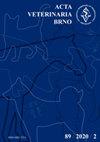Slanted slot was the most resistant to failure of ventral slot techniques tested in rabbit cervical vertebrae
IF 0.6
4区 农林科学
Q3 VETERINARY SCIENCES
引用次数: 0
Abstract
The ventral slot technique is used to relieve neural compression secondary to intervertebral disc degeneration or disease. In the present study, the biomechanical properties of three different ventral surgical procedures in the rabbit C6–C7 vertebral motion unit (VMU) were assessed and compared with the intact C6–C7 VMU. The ventral slot procedure (slanted, full, or mini; n = 8/group) was performed on these cervical vertebrae. Normal spine torsion and flexion values were compared to those of spines subjected to slanted, full, and mini slot surgery. The slanted slot spines were the most stable, maintaining 70% of normal cervical spine strength, compared to 26% with the full slot and 30% with the mini slot. Regarding torsion, slanted slot spines showed 74% stability compared to the normal cervical spine, while the full slot and mini slot spines showed 58% and 62% stability, respectively. Flexion values were lower after all versions of the ventral slot procedure than in the normal spine, with the greatest flexion difference occurring after the full slot procedure (21% of the normal flexion value). The flexion values also differed significantly between the slanted and full spine groups, and all operated spines showing roughly 60% torsion rates compared with normal spines. The slanted slot maintains more stability in rabbit cervical spine than the other procedures. To our knowledge, this was the first study to examine biomechanical failure differences between the distinct versions of this ventral slot procedure.斜槽是兔颈椎腹侧槽技术中最抗失败的方法
腹侧椎槽技术用于缓解椎间盘退变或疾病引起的神经压迫。本研究评估了兔C6-C7椎体运动单元(VMU)的三种不同腹侧手术方式的生物力学特性,并与完整的C6-C7椎体运动单元(VMU)进行了比较。腹侧切口手术(倾斜的、全的或小的;N = 8/组)。将正常脊柱扭转和屈曲值与接受斜槽、全槽和小槽手术的脊柱进行比较。斜槽脊柱最稳定,可维持70%的正常颈椎强度,而全槽脊柱为26%,小槽脊柱为30%。在扭转方面,斜槽型颈椎的稳定性为正常颈椎的74%,而全槽型和小槽型颈椎的稳定性分别为58%和62%。所有版本的腹侧槽手术后脊柱的屈曲值都低于正常脊柱,其中最大的屈曲差异发生在全槽手术后(正常屈曲值的21%)。倾斜脊柱组和完整脊柱组的屈曲值也有显著差异,与正常脊柱相比,所有手术脊柱的扭转率约为60%。与其他手术相比,斜槽手术对兔颈椎的稳定性更好。据我们所知,这是第一次研究不同版本的腹侧切口手术的生物力学失败差异。
本文章由计算机程序翻译,如有差异,请以英文原文为准。
求助全文
约1分钟内获得全文
求助全文
来源期刊

Acta Veterinaria Brno
农林科学-兽医学
CiteScore
1.00
自引率
33.30%
发文量
36
审稿时长
18-36 weeks
期刊介绍:
ACTA VETERINARIA BRNO is a scientific journal of the University of Veterinary and Pharmaceutical Sciences in Brno, Czech Republic.
The scientific journal Acta Veterinaria Brno is dedicated to the publication of original research findings and clinical observations in veterinary and biomedical sciences. Original scientific research articles reporting new and substantial contribution to veterinary science and original methods that have not been submitted for publication elsewhere are considered for publication. A written statement to this effect should accompany the manuscript, along with approval for publication by the author´s head of department. The authors bear full responsibility for the contents of their contribution. Book reviews are published, too.
 求助内容:
求助内容: 应助结果提醒方式:
应助结果提醒方式:


